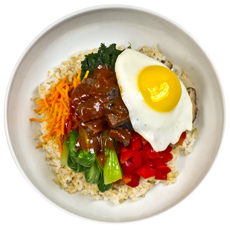TIP OF THE DAY: Easy Homemade Bibimbap
|
One of our favorite Korean dishes is bibimbap (pronounced BEE-bim-bop), a comfort food recipe that’s easily customizable to your tastes. It combines rice, protein, fresh vegetables and spicy Korean barbeque sauce. The dish is traditionally made, mixed and served in a Korean stone bowl (also called hotstone or dolsot). You can use a regular skillet and a dinner plate. With a stone bowl, the rice on the bottom becomes extra crisp and crusty and is considered a bonus, like the socarrat on the bottom of paella pans. Already low in calories and healthful, if you substitute a [nontraditional] whole grain for the white rice, it becomes a very nutritious dish. Consider black, brown or red rice, or barley (bap is the Korean word for cooked rice). Quinoa fans: Go for it! Below are five easy steps to making bibimbap at home from Bibigo, maker of Korean pantry products. RECIPE: HOMEMADE BIBIMBAP Ingredients |

Bibimbap served in a traditional stone bowl. Photo courtesy Barnjoo Restaurant | NYC. |
|
|
Gochujang (pronounced ko-chu-JONG, also translated as kochujang) is a Korean hot chile pepper paste, spicy, but not too hot. It is made from glutinous (sticky) rice, red chiles, fermented soy beans and salt. Gochujang is one of the three indispensable condiments in Korean households, along with doenjang, bean paste, and ganjang, Korean soy sauce. The popular condiment is used in bibimbap as well as in bulgogi (barbecued meat wrapped in lettuce leaves), tteokbokki (a snack food made from soft rice cake and fish cake), and in salads, stews, soups and marinated meat dishes. You can also spread it on burgers and sandwiches for some fusion flare, use it as a breakfast condiment with eggs or hash browns, or mix it with soy sauce, rice wine and a bit of brown sugar to make a delicious dipping sauce. |
||
|
|
RECIPE: BIBIMBAP This dish is primed for “freestyling.” You can add whatever ingredients appeal to you, from edamame to rice noodles, to create your own signature bibimbap. |
|
|
Preparation 1. DIVIDE the rice and vegetables between two serving bowls; set aside. 2. MAKE the marinade: Combine soy sauce, sugar, garlic, ginger, sesame oil and pepper in a mixing bowl. 3. COMBINE the marinade and protein in a skillet over medium-high heat, and stir frequently until just cooked through. 4. TOP the rice with the cooked protein, reserving the cooking juices. Mix the juices with the gochujang sauce. 5. FRY the eggs sunny-side up and place one on top of each rice bowl. Garnish to taste and serve with gochujang sauce. |
||
